Objective: To assess the efficacy, safety, and tolerability of brexpiprazole as adjunct to antidepressant treatment (ADT) in adults with major depressive disorder (MDD) and inadequate response to ADTs.
Methods: Outpatients with inadequate response to 1-3 ADTs during their current depressive episode (DSM-IV-TR criteria) were administered prospective, open-label ADT. Those patients with inadequate response to prospective ADT were randomized to double-blind, adjunctive brexpiprazole 2 mg/d or placebo. The primary efficacy end point was the change from baseline (randomization) to week 6 in Montgomery-Åsberg Depression Rating Scale (MADRS) total score. Key secondary efficacy end points were the change in Sheehan Disability Scale (SDS) mean score for all patients and the change in MADRS total score for subgroups with minimal response to prospective ADT and DSM-5-defined anxious distress. The study was conducted from July 2014 to May 2016.
Results: Adjunctive brexpiprazole (n = 191) improved MADRS total score from baseline to week 6 versus placebo (n = 202; least squares mean difference [95% confidence limits]: −2.30 [−3.97, −0.62]; P = .0074). There was no separation between groups for the SDS mean score (−0.22 [−0.66, 0.23]; P = .33). Adjunctive brexpiprazole also improved MADRS total score versus placebo in the subgroups with minimal response to prospective ADT (−2.25 [−4.23, −0.27]; P = .026) and anxious distress (−2.98 [−5.24, −0.72]; P = .0099). Treatment with adjunctive brexpiprazole was well tolerated with no unexpected side effects.
Conclusions: This study adds to the substantial body of evidence for the efficacy and tolerability of brexpiprazole as adjunctive treatment in patients with MDD and inadequate response to ADTs.
Trial Registration: ClinicalTrials.gov identifier: NCT02196506; EudraCT number: 2014-000062-22‘ ‹’ ‹’ ‹
A Randomized, Placebo-Controlled Study of the
Efficacy and Safety of Fixed-Dose Brexpiprazole 2 mg/d as Adjunctive Treatment of Adults With Major Depressive Disorder
ABSTRACT
Objective: To assess the efficacy, safety, and tolerability of brexpiprazole as adjunct to antidepressant treatment (ADT) in adults with major depressive disorder (MDD) and inadequate response to ADTs.
Methods: Outpatients with inadequate response to 1–3 ADTs during their current depressive episode (DSM-IV-TR criteria) were administered prospective, open-label ADT. Those patients with inadequate response to prospective ADT were randomized to double-blind, adjunctive brexpiprazole 2 mg/d or placebo. The primary efficacy end point was the change from baseline (randomization) to week 6 in Montgomery-Åsberg Depression Rating Scale (MADRS) total score. Key secondary efficacy end points were the change in Sheehan Disability Scale (SDS) mean score for all patients and the change in MADRS total score for subgroups with minimal response to prospective ADT and DSM-5–defined anxious distress. The study was conducted from July 2014 to May 2016.
Results: Adjunctive brexpiprazole (n = 191) improved MADRS total score from baseline to week 6 versus placebo (n = 202; least squares mean difference [95% confidence limits]: −2.30 [−3.97, −0.62]; P = .0074). There was no separation between groups for the SDS mean score (−0.22 [−0.66, 0.23]; P = .33). Adjunctive brexpiprazole also improved MADRS total score versus placebo in the subgroups with minimal response to prospective ADT (−2.25 [−4.23, −0.27]; P = .026) and anxious distress (−2.98 [−5.24, −0.72]; P = .0099). Treatment with adjunctive brexpiprazole was well tolerated with no unexpected side effects.
Conclusions: This study adds to the substantial body of evidence for the efficacy and tolerability of brexpiprazole as adjunctive treatment in patients with MDD and inadequate response to ADTs.
Trial Registration: ClinicalTrials.gov identifier: NCT02196506; EudraCT number: 2014-000062-22
J Clin Psychiatry 2018;79(4):17m12058
To cite: Hobart M, Skuban A, Zhang P, et al. A randomized, placebo-controlled study of the efficacy and safety of fixed-dose brexpiprazole 2 mg/d as adjunctive treatment of adults with major depressive disorder. J Clin Psychiatry. 2018;79(4):17m12058.
To share: https://doi.org/10.4088/JCP.17m12058
© Copyright 2018 Physicians Postgraduate Press, Inc.
aOtsuka Pharmaceutical Development & Commercialization Inc., Princeton, New Jersey
bH. Lundbeck A/S, Valby, Copenhagen, Denmark
*Corresponding author: Mary Hobart, PhD, Otsuka Pharmaceutical Development & Commercialization Inc., 508 Carnegie Center Drive, 1 University Sq Drive, Princeton, NJ 08540 ([email protected]).
Major depressive disorder (MDD) is a recurrent, chronic, and seriously impairing disorder. Despite the availability of different classes of antidepressants, approximately 50% of patients with MDD do not achieve response with antidepressant treatment (ADT), as shown in the Sequenced Treatment Alternatives to Relieve Depression (STAR*D) study1 and in a meta-analysis2 of 182 randomized, double-blind, placebo-controlled trials. Patients with MDD who do not adequately respond to ADT are at risk of reduced quality of life, lower functional status, and reduced well-being.3 Failure to achieve full remission is associated with poor work functioning and increased social and economic costs.4
For patients with inadequate response to ADT, treatment options include switching to another antidepressant, adding a second antidepressant in combination, or adding another medication as adjunctive therapy (eg, lithium, thyroid hormone, atypical antipsychotics, stimulants).5 Although lithium has shown a benefit adjunct to tricyclic antidepressants in small trials,6 there is little evidence to support lithium augmentation of newer antidepressants, and the relevance of lithium augmentation to contemporary clinical practice is unclear.5 In contrast, atypical antipsychotics have been systematically and rigorously studied adjunct to selective serotonin reuptake inhibitors and serotonin-norepinephrine reuptake inhibitors in large randomized controlled trials, and are supported by the strongest evidence base.5,7 Furthermore, atypical antipsychotics are the only class with agents approved for the adjunctive therapy of MDD by the US Food and Drug Administration. Specifically, aripiprazole, brexpiprazole, and quetiapine extended-release (XR) are indicated for the adjunctive treatment of MDD, and olanzapine-fluoxetine combination is indicated for the treatment of treatment-resistant depression.
Brexpiprazole is a serotonin-dopamine activity modulator that acts as a partial agonist at serotonin 5-HT1A and dopamine D2 receptors and as an antagonist at serotonin 5-HT2A and norepinephrine α1B/2C receptors, all with subnanomolar potency.8 The efficacy and safety of brexpiprazole as adjunctive treatment to ADT during 6 weeks have been demonstrated in 2 fixed-dose studies in MDD,9,10 which were used for US registration. The primary objective of the present study (the Sirius study) was to further assess the efficacy of brexpiprazole (2 mg/d) as adjunctive treatment to ADT in patients with MDD who have demonstrated an inadequate response to prospective ADT. Secondary objectives included an assessment of the efficacy of adjunctive brexpiprazole in the subgroup of patients who demonstrated minimal improvement on prospective ADT and in the subgroup with anxious distress. Safety and tolerability were also assessed.
METHODS
The Sirius study was registered with ClinicalTrials.gov (NCT02196506; https://clinicaltrials.gov/) and EudraCT (2014-000062-22; https://eudract.ema.europa.eu/). The study was conducted in accordance with the International Conference on Harmonisation Good Clinical Practice Guideline and local regulatory requirements. The study protocol was approved by relevant institutional review boards and independent ethics committees. All patients provided written informed consent prior to the start of the study, and possible side effects were fully explained.
Patients
Patients were enrolled by investigators at 51 sites in the United States (60.5% of patients), Germany (11.4%), Poland (11.4%), Slovakia (9.2%), and Hungary (7.6%). The study started on July 9, 2014, and was completed on May 20, 2016.
Eligible patients were male or female outpatients, aged 18–65 years, with a diagnosis of MDD and a current nonpsychotic major depressive episode of ≥ 8 weeks’ duration as defined by the Diagnostic and Statistical Manual of Mental Disorders, Fourth Edition, Text Revision (DSM-IV-TR).11 Patients had an inadequate response to 1–3 prior ADTs during the current episode, defined as < 50% improved on a therapeutic dose for an adequate duration (≥ 6 weeks) according to the Massachusetts General Hospital Antidepressant Treatment Response Questionnaire.12 Patients were also required to have a 17-item Hamilton Depression Rating Scale (HDRS17)13,14 total score of ≥ 18 at screening and on the first day of prospective treatment. Key exclusion criteria were treatment with adjunctive antipsychotic medication for ≥ 3 weeks during the current episode, a specified DSM-IV-TR Axis I diagnosis other than MDD, suicidal ideation or behavior, or substance abuse or dependence within the past 180 days.
Study Design
Sirius was a randomized, double-blind, placebo-controlled study of the efficacy and safety of fixed-dose brexpiprazole (2 mg/d) as adjunctive therapy in the treatment of adults with MDD. The study comprised an 8-week, single-blind, prospective treatment phase followed by a 6-week, double-blind, randomized treatment phase for patients who did not fully respond to prospective treatment (see Supplementary Figure 1 at PSYCHIATRIST.COM).
In the prospective treatment phase, patients received an investigator-determined, open-label ADT together with single-blind placebo. During this phase, patients were assessed for inadequate response, defined as meeting all of the following criteria: < 50% reduction in HDRS17 total score from the start to the end of prospective treatment; HDRS17 total score ≥ 14 at the end of prospective treatment; Clinical Global Impressions-Improvement (CGI-I)15 score ≥ 3 (minimally improved) at weeks 2, 4, 6, and 8 of the prospective treatment phase; and < 50% reduction in Montgomery-Åsberg Depression Rating Scale (MADRS)16 total score between the start of prospective treatment and weeks 2, 4, 6, and 8 of the prospective treatment phase. The criteria for inadequate response were blinded from the investigators and site staff; scores were entered into, and assessed by, an interactive web response system (IWRS) to maintain the blinding.
Patients who did not meet the criteria for inadequate response (ie, responders to prospective ADT) continued to receive the same open-label ADT and single-blind placebo until the end of the study; these patients were not randomized or included in the analyses.
Patients meeting the criteria for inadequate response were randomized in a 1:1 ratio to double-blind adjunctive brexpiprazole 2 mg/d or placebo for 6 weeks. Brexpiprazole was titrated such that patients received 0.5 mg/d during the first week, 1 mg/d during the second week, and 2 mg/d (therapeutic dose) from the third week onward. Adjunctive treatments were administered orally once daily. Treatments were assigned by the IWRS based on a fixed-block, computer-generated randomization code provided by the study sponsor, stratified by study center. Treatment assignments were blinded to patients, investigators, and sponsor personnel, including those involved in data analysis. Brexpiprazole and matching placebo tablets were provided by the sponsor, packaged in numbered, weekly blister cards.
Following study completion or withdrawal, patients were prescribed appropriate ADT and had a safety follow-up via telephone or clinic visit 30 days after the last dose of study medication.
Assessments
Efficacy was assessed using clinician-rated scales for depressive symptoms (MADRS,16 HDRS1713,14) and overall illness severity (CGI-Severity of Illness [CGI-S],15 CGI-I15). Functioning was assessed using the patient-rated Sheehan Disability Scale (SDS), comprising 3 items (work/studies, social life, and family life) that are each scored from 0 (not at all disrupted) to 10 (extremely disrupted).17 During the randomized treatment phase, efficacy assessments were made at baseline (randomization) and at each weekly visit (except at baseline and weeks 3 and 6 only for the SDS and at baseline and week 6 only for the HDRS17).
Safety and tolerability assessments at each visit included adverse event (AE) reporting, assessments of extrapyramidal symptoms (EPS) (Simpson-Angus Scale [SAS],18 Abnormal Involuntary Movement Scale [AIMS; baseline and week 6 only],15 and Barnes Akathisia Rating Scale [BARS]19), suicidality (Columbia Suicide Severity Rating Scale [C-SSRS]20), sexual functioning (Massachusetts General Hospital Sexual Functioning Questionnaire [MSFQ; baseline and week 6 only]21), and standard safety assessments at various time points including body weight, electrocardiograms, vital signs, and laboratory measurements.
Data Analysis
Sample size was calculated based on an expected between-group difference of 3.0 points (standard deviation, 8.3) in the mean change in MADRS total score from baseline to week 6 of the randomized treatment phase, based upon the results of a previous study.9 A sample size of 324 evaluable patients (162 in each treatment group) was projected to yield at least 90% power to detect the treatment effects at a 2-sided significance level of .05.
Safety analyses were performed in the safety population, defined as all randomized patients who took at least 1 dose of double-blind medication in the randomized treatment phase. Efficacy analyses were conducted in the efficacy population, defined as all patients in the safety population who had a baseline and at least 1 postbaseline MADRS total evaluation. Baseline measurements were defined as the last available measurement prior to receiving the first dose of randomized treatment (provided that the measurement took place in the 2 weeks prior to the randomization visit).
The primary efficacy end point was the change from baseline to week 6 in MADRS total score, analyzed using mixed-model repeated measures (MMRM) with fixed class effect terms for treatment, study center, and visit week and an interaction term of treatment by visit week. The interaction term of baseline MADRS total score by visit week was included as covariate. The primary treatment comparison (ADT + brexpiprazole vs ADT + placebo) was tested at a significance level of .05 (2-sided), using least squares mean differences (LSMDs).
The first key secondary efficacy end point was the change from baseline to week 6 in SDS mean score (defined as the mean of the 3 SDS items). Following a protocol amendment prior to the start of the study, 2 other key secondary efficacy end points were added to generate a better understanding of the effect of brexpiprazole in 2 prespecified populations. These end points were the change from baseline to week 6 in MADRS total score for (1) the subgroup with minimal response to prospective ADT (defined as < 25% reduction in MADRS total score from the start to the end of prospective treatment) and (2) the subgroup with anxious distress at screening (defined using the Diagnostic and Statistical Manual of Mental Disorders, Fifth Edition [DSM-5], anxious distress specifier22; Supplementary Table 1). SDS mean score was analyzed using the same MMRM model as for the primary analysis; the other 2 key secondary efficacy variables used the same model but without the fixed class effect term for study center. A hierarchical testing procedure was employed to maintain the overall experiment-wise type I error rate at a level of .05.
Other secondary efficacy end points were evaluated at a nominal .05 level (2-sided). Change from baseline in CGI-S score was analyzed using the same MMRM model as for the primary analysis. Change from baseline in HDRS17 total score was assessed using analysis of covariance (ANCOVA) (last observation carried forward [LOCF]). Mean CGI-I score at each visit was analyzed using the Cochran-Mantel-Haenszel (CMH) row mean scores differ test, controlling for study center (LOCF). MADRS response, defined as a ≥ 50% reduction from baseline in MADRS total score, and CGI-I response, defined as a CGI-I score of 1 (very much improved) or 2 (much improved), were evaluated using the CMH general association test, controlling for study center (LOCF). MADRS remission, defined as a ≥ 50% reduction from baseline in MADRS total score and a MADRS total score ≤ 10, was also evaluated using the CMH general association test (LOCF).
Safety and tolerability outcomes are presented using descriptive statistics. For the SAS, AIMS, BARS, body weight, and MSFQ assessments, the change from baseline was evaluated using ANCOVA (observed cases).
All analyses were performed using SAS 9.4 software (SAS Institute Inc., Cary, North Carolina).
RESULTS
Patients
Of the 837 patients who entered the prospective treatment phase, 121 (14.5%) discontinued before the end of the phase, 322 (38.5%) demonstrated response to ADT + placebo and were therefore not randomized (and were excluded from the analyses), and 394 (47.1%) demonstrated inadequate response to ADT + placebo and were eligible for randomization (Figure 1). Inadequate responders continued to receive the same ADT and were randomized to adjunctive brexpiprazole 2 mg/d (n = 192) or adjunctive placebo (n = 202). Of the randomized patients, 177 (92.2%) receiving ADT + brexpiprazole and 196 (97.0%) receiving ADT + placebo completed the randomized treatment phase. The most common reasons for discontinuation were withdrawal of consent (4.2% for ADT + brexpiprazole, 0.5% for ADT + placebo) and adverse events (2.1% for ADT+brexpiprazole, 0.5% for ADT + placebo).
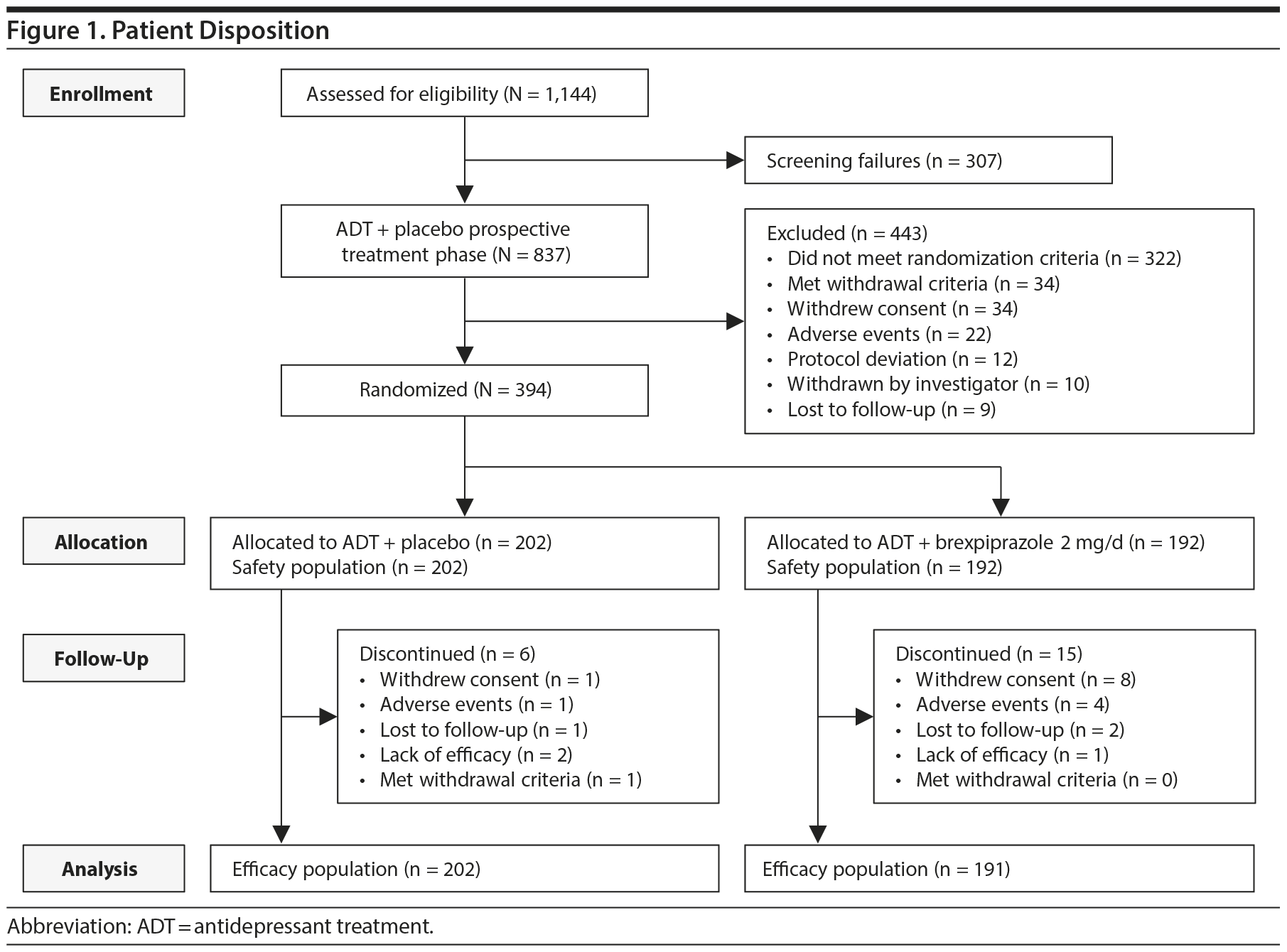
Baseline demographic and clinical characteristics of the randomized population were similar between treatment groups (Table 1). Patients were moderately ill at baseline.
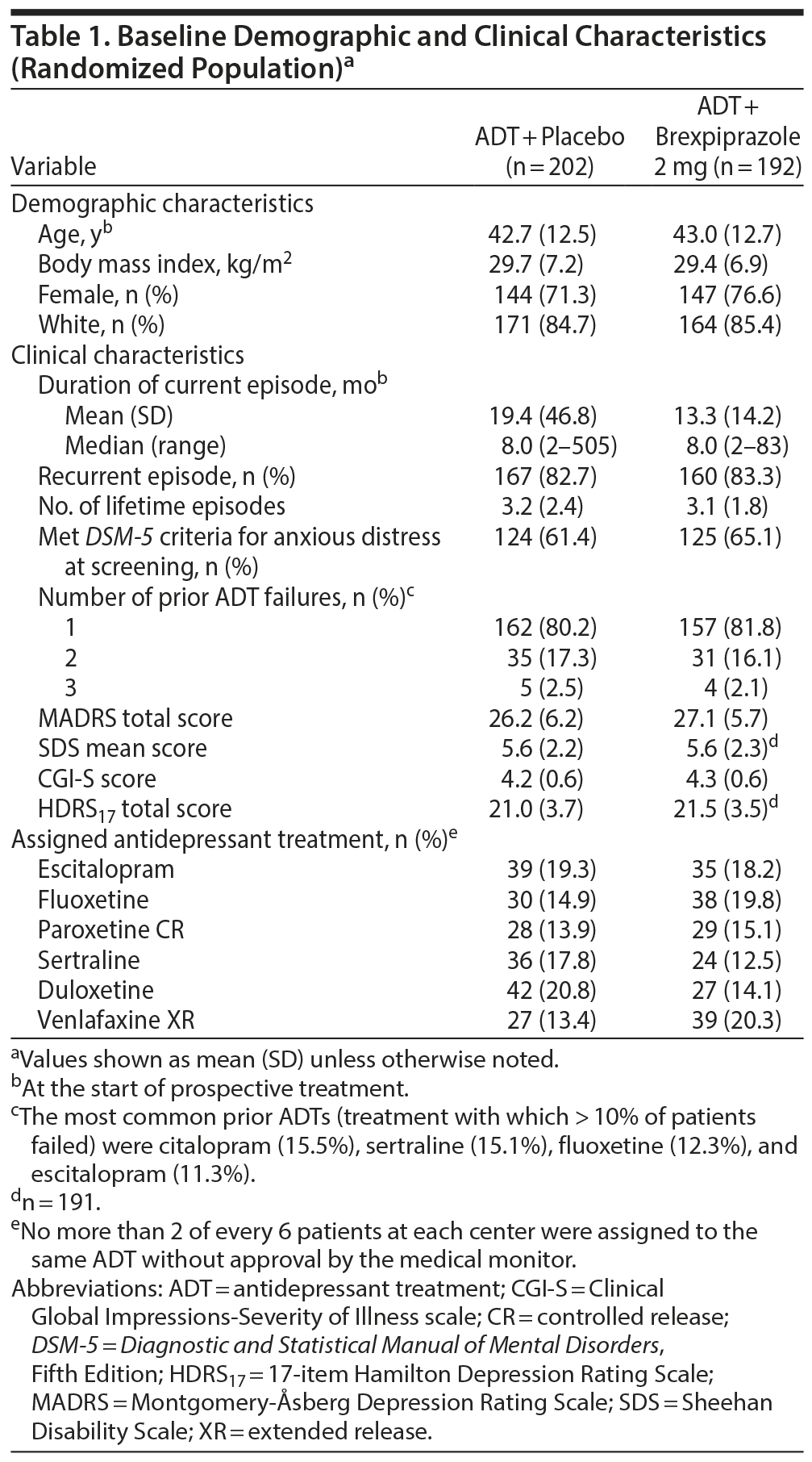
Efficacy
On the primary efficacy end point of change in MADRS total score from baseline to week 6 (Figure 2; Table 2), improvement was statistically significantly greater in the ADT + brexpiprazole group than in the ADT + placebo group (LSMD [95% confidence limits]: −2.30 [−3.97, −0.62]; P = .0074).
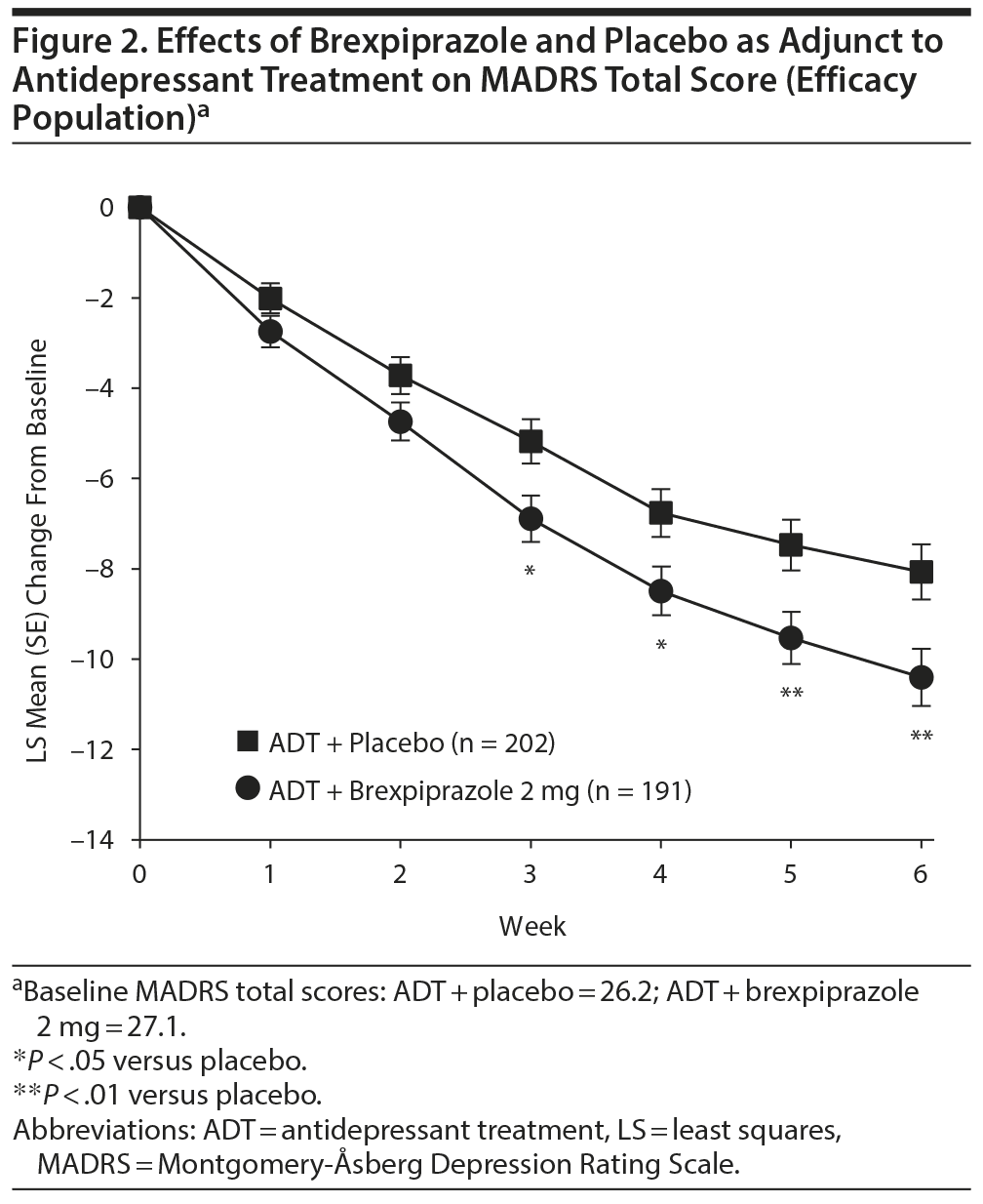
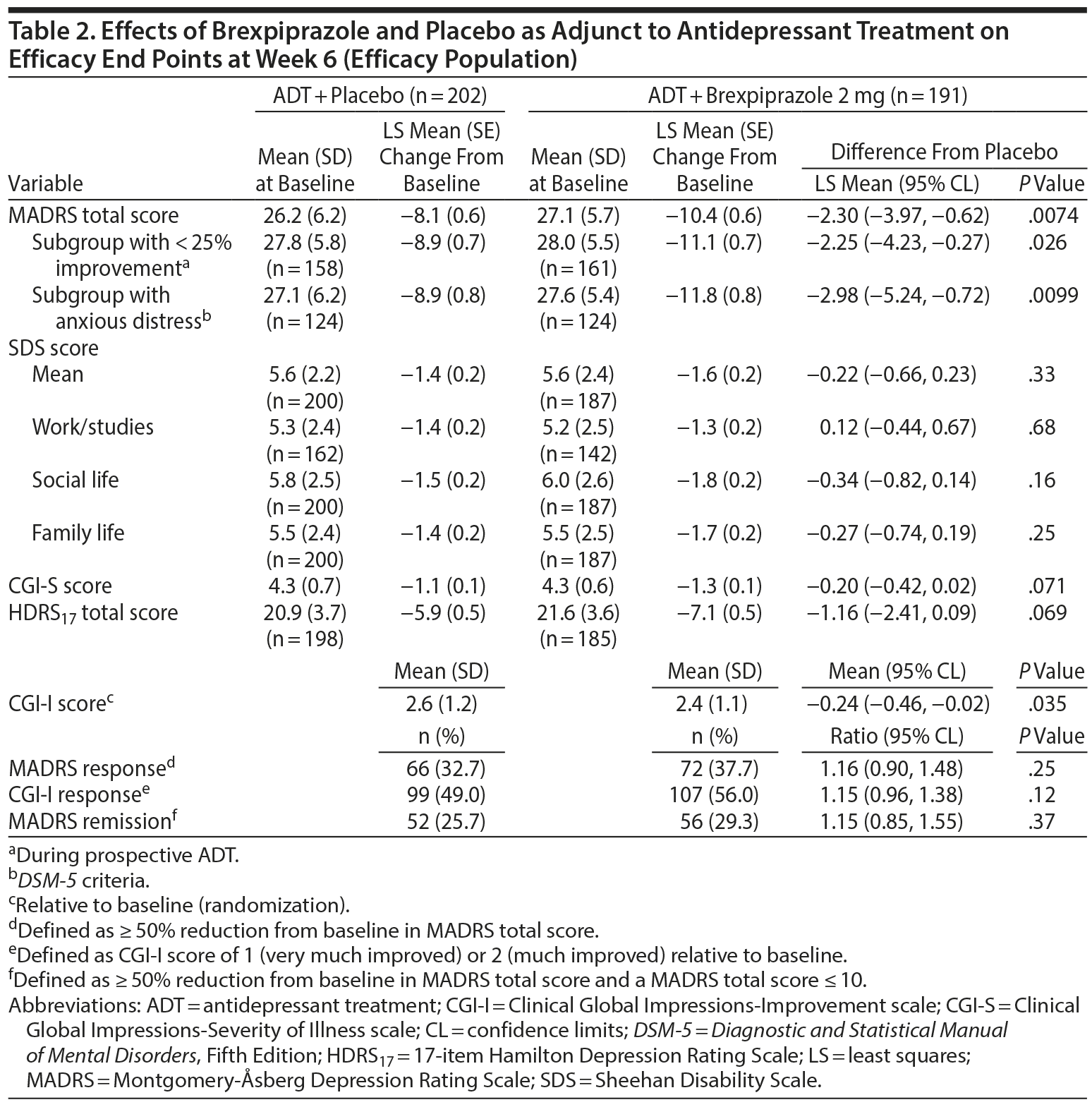
On the first key secondary efficacy end point of change in SDS mean score from baseline to week 6 (Table 2), the ADT + brexpiprazole group had a greater numerical improvement from baseline to week 6 than the ADT + placebo group (LSMD: −0.22 [−0.66, 0.23]); however, this difference was not statistically significant (P = .33), and the formal hierarchical testing procedure was terminated. ADT + brexpiprazole showed numerical benefits over ADT + placebo on the SDS items of social life and family life, but not work/studies (Table 2).
On the second and third key secondary efficacy end points, the ADT + brexpiprazole group showed greater improvement in MADRS total score from baseline to week 6 than the ADT + placebo group in the subgroup of patients with < 25% improvement during prospective ADT and the subgroup of patients with DSM-5 anxious distress at screening, with nominal P values of .026 and .0099, respectively (Table 2). Of the other secondary efficacy end points, only CGI-I score favored ADT + brexpiprazole at week 6 (Table 2).
Safety and Tolerability
From baseline (the start of the randomized treatment phase), more patients experienced treatment-emergent AEs (TEAEs) in the ADT + brexpiprazole group than in the ADT + placebo group (59.9% vs 49.5%) (Table 3). The most frequent TEAEs in patients receiving ADT + brexpiprazole were akathisia (8.3%), restlessness (8.3%), upper respiratory tract infection (5.2%), and increased weight (5.2%) (Table 3). Nausea and vomiting were infrequent (≤ 1%) with brexpiprazole, and all sedating TEAEs had an incidence < 5%. The majority of TEAEs were mild or moderate in severity.
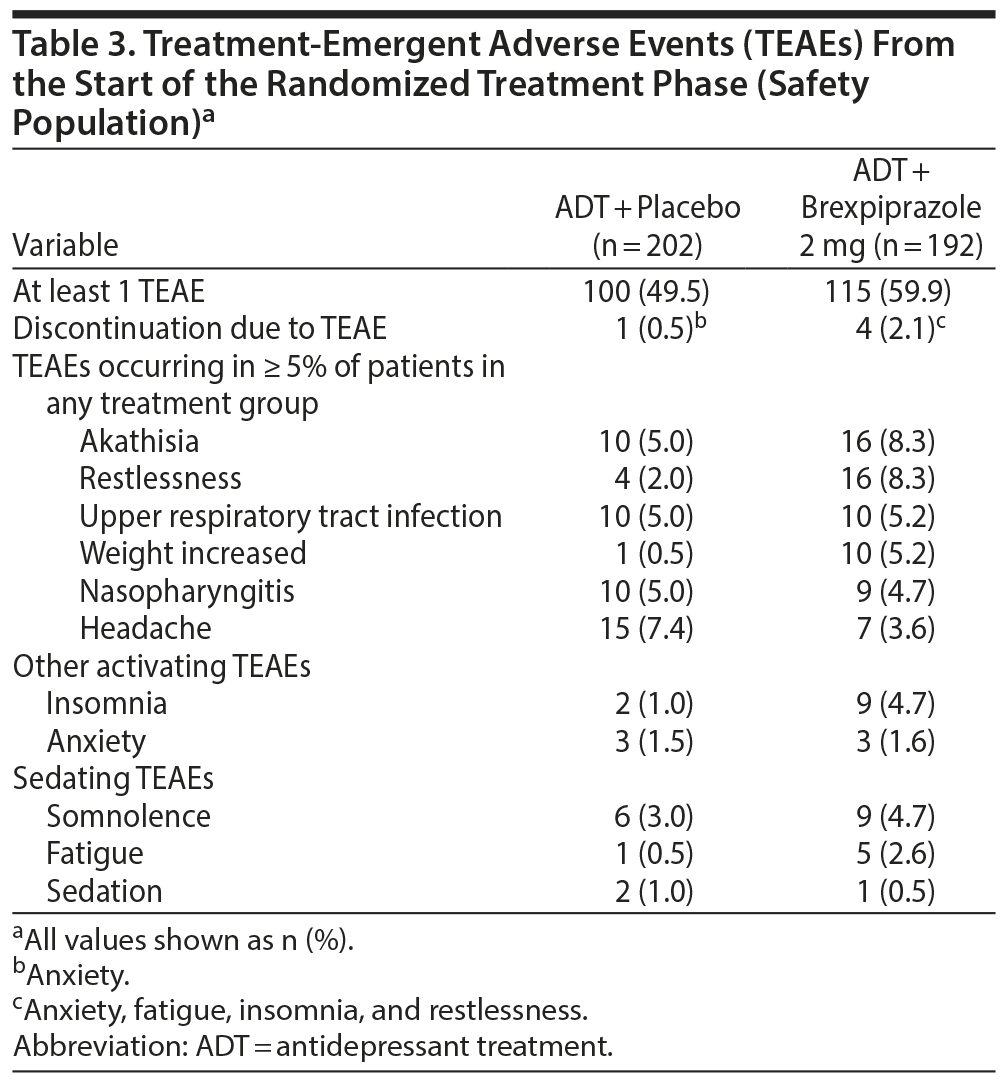
The incidence of EPS-related TEAEs was higher among patients receiving brexpiprazole (11.5%) than those receiving placebo (6.9%). The most frequently reported EPS-related TEAE was akathisia (Table 3). In the analysis of change from baseline in EPS scale scores, only the BARS global score showed a small treatment difference between ADT + brexpiprazole and ADT + placebo at last visit, in favor of ADT + placebo (Supplementary Table 2).
The mean (SD) change in body weight from baseline to week 6 was 1.5 (2.1) kg (3.3 [4.6] lb) for ADT + brexpiprazole (n = 177) and 0.5 (1.9) kg (1.1 [4.2] lb) for ADT + placebo (n = 196; P < .0001). Increase in body weight ≥ 7% at any postbaseline visit was reported by 8 (4.2%) of 192 patients receiving ADT + brexpiprazole and 2 (1.0%) of 202 patients receiving ADT + placebo. The assessment of electrocardiograms, vital signs, and laboratory measurements (including glucose, total cholesterol, and triglycerides; Supplementary Table 3) did not show any consistent differences between the ADT + brexpiprazole and ADT + placebo groups.
No suicidal behavior was reported on the C-SSRS during the randomized treatment phase, and the incidence of treatment-emergent suicidal ideation was lower in the ADT + brexpiprazole group (3.6%) than in the ADT + placebo group (7.4%). No patients died during the study.
In terms of sexual functioning, greater improvement from baseline to last visit was seen for ADT + brexpiprazole versus ADT + placebo on the MSFQ individual items of “interest in sex” and “sexually aroused” (Supplementary Table 4). One patient in each treatment group experienced a TEAE of decreased libido, and 1 patient in the ADT + brexpiprazole group had a TEAE of anorgasmia.
DISCUSSION
The Sirius study confirms the results of 2 previous studies9,10 showing that brexpiprazole adjunct to ADT is efficacious for treating depressive symptoms, based on MADRS total score, among patients with inadequate response (< 50% improvement) to ADT. A benefit for brexpiprazole was observed at each week in which the therapeutic dose was received (week 3 onward). The LSMD between brexpiprazole 2 mg/d and placebo at week 6 was −2.3, comparable with the differences found in the previous studies (2 mg/d, −3.2; and 3 mg/d, −2.0).9,10 This degree of improvement is above the minimum clinically important difference for the MADRS total, believed to be around 2 points.23,24 The benefit of brexpiprazole on MADRS total score is also comparable to that of other adjunctive atypical antipsychotics in MDD, as observed in a meta-analysis25 of randomized controlled trials (aripiprazole, 3.2 points over 6 weeks; quetiapine XR, 2.7 points over 6 weeks; olanzapine-fluoxetine combination, 2.6 points over 8–12 weeks).
Adjunctive brexpiprazole was also associated with a greater improvement than placebo in the subgroup of patients who demonstrated minimal improvement (< 25%) during prospective ADT. This was a prespecified secondary end point, the result of which suggests that brexpiprazole is beneficial in hard-to-treat patients who have garnered little benefit from ADT. Greater improvement was also shown in the subgroup of patients with anxious distress at screening. Anxious distress in MDD is associated with more severe depression and reduced workplace productivity.26 In general, anxiety symptoms among patients with depression are associated with greater suicidal ideation, reduced likelihood of response to antidepressant treatment, and a longer time to response.27 In this prospectively defined analysis, brexpiprazole had a numerically greater effect in patients with anxious distress than in the whole study population.
In terms of functioning, in the brexpiprazole MDD US registration studies,9,10 adjunctive brexpiprazole showed greater improvement than adjunctive placebo on the SDS mean score. In Sirius, adjunctive brexpiprazole showed numerical advantages over adjunctive placebo on the SDS mean score (and the items of social life and family life), but failed to separate at a significance level of .05. This difference may be attributed, in part, to a greater benefit of placebo on the SDS mean score in Sirius compared with previous studies.
As in previous brexpiprazole studies,9,10 Sirius had a high completion rate in both treatment arms (> 90%), indicating that adjunctive brexpiprazole was well tolerated. The most commonly reported TEAEs in the ADT + brexpiprazole group were akathisia (8.3%) and restlessness (8.3%). The incidence of akathisia was consistent with observations in other short-term brexpiprazole MDD studies (9.2%),28 whereas restlessness had a higher incidence than in previous short-term studies (3.4%),28 potentially linked to a higher proportion of patients with anxious distress in Sirius than in previous studies. No excessive effect on weight was observed (1.5 kg increase over 6 weeks), and 3% more patients receiving adjunctive brexpiprazole than placebo had a ≥ 7% increase in body weight, which is consistent with other short-term brexpiprazole MDD studies.28 Changes in EPS rating scale scores were small and not considered clinically meaningful. With the exception of akathisia and restlessness, activating and sedating side effects were infrequent among patients who received brexpiprazole. Nausea and vomiting were also infrequent, and there was no clinically relevant adverse effect on prolactin or sexual function. The tolerability of brexpiprazole may be partially attributed to its intrinsic activity at D2 receptors, which is lower than that of aripiprazole.8 Thus, brexpiprazole may be less likely to induce D2-agonist–mediated adverse effects (such as akathisia and nausea) than aripiprazole, as well as being less likely to induce D2-antagonist–mediated side effects (such as EPS and hyperprolactinemia) than antipsychotics associated with dopaminergic blockade.29–31
Limitations for Sirius were the relatively short duration of double-blind treatment and the lack of an active comparator, such as another approved adjunctive antipsychotic. The study evaluated the effects of brexpiprazole in patients with MDD and inadequate response to ADTs. However, due to the patient selection criteria (outpatients with no psychotic symptoms and low suicide risk) and restrictions regarding concomitant medications and comorbidities, the results are of limited generalizability. Finally, the protocol did not exclude patients who had previously received adjunctive antipsychotics unless these agents were taken for > 3 weeks.
In conclusion, Sirius adds to the substantial body of evidence for the efficacy of brexpiprazole 2 mg/d as adjunctive treatment in patients with MDD with inadequate response to ADTs. Treatment with brexpiprazole was well tolerated, and no unexpected side effects were observed.
Submitted: December 4, 2017; accepted April 13, 2018.
Published online: May 22, 2018.
Potential conflicts of interest: Drs Hobart, Skuban, Zhang, Sanchez, and McQuade and Ms Augustine and Ms Brewer are employees of Otsuka Pharmaceutical Development & Commercialization Inc. Mr Hefting is an employee of H. Lundbeck A/S.
Funding/support: This study was supported by Otsuka Pharmaceutical Development & Commercialization Inc., Princeton, NJ, and H. Lundbeck A/S, Valby, Denmark.
Role of the sponsor: The sponsors were responsible for the study design and conduct; the collection, management, analysis, and interpretation of the data; and the writing and reviewing of this article.
Previous presentation: Poster presented at the 55th Annual Meeting of the American College of Neuropsychopharmacology; December 4–8, 2016; Hollywood, Florida.
Acknowledgments: Writing support was provided by Chris Watling, PhD, assisted by his colleagues at Cambridge Medical Communication Ltd, Cambridge, UK, and funded by Otsuka Pharmaceutical Development & Commercialization Inc. and H. Lundbeck A/S.
Supplementary material: Available at PSYCHIATRIST.COM.
REFERENCES
1. Rush AJ, Trivedi MH, Wisniewski SR, et al. Acute and longer-term outcomes in depressed outpatients requiring one or several treatment steps: a STAR*D report. Am J Psychiatry. 2006;163(11):1905–1917. PubMed CrossRef
2. Papakostas GI, Fava M. Does the probability of receiving placebo influence clinical trial outcome? a meta-regression of double-blind, randomized clinical trials in MDD. Eur Neuropsychopharmacol. 2009;19(1):34–40. PubMed CrossRef
3. Mauskopf JA, Simon GE, Kalsekar A, et al. Nonresponse, partial response, and failure to achieve remission: humanistic and cost burden in major depressive disorder. Depress Anxiety. 2009;26(1):83–97. PubMed CrossRef
4. McIntyre RS, O’Donovan C. The human cost of not achieving full remission in depression. Can J Psychiatry. 2004;49(3 suppl 1):10S–16S. PubMed
5. Connolly KR, Thase ME. If at first you don’t succeed: a review of the evidence for antidepressant augmentation, combination and switching strategies. Drugs. 2011;71(1):43–64. PubMed CrossRef
6. Crossley NA, Bauer M. Acceleration and augmentation of antidepressants with lithium for depressive disorders: two meta-analyses of randomized, placebo-controlled trials. J Clin Psychiatry. 2007;68(6):935–940. PubMed CrossRef
7. Nelson JC, Papakostas GI. Atypical antipsychotic augmentation in major depressive disorder: a meta-analysis of placebo-controlled randomized trials. Am J Psychiatry. 2009;166(9):980–991. PubMed CrossRef
8. Maeda K, Sugino H, Akazawa H, et al. Brexpiprazole I: in vitro and in vivo characterization of a novel serotonin-dopamine activity modulator. J Pharmacol Exp Ther. 2014;350(3):589–604. PubMed CrossRef
9. Thase ME, Youakim JM, Skuban A, et al. Efficacy and safety of adjunctive brexpiprazole 2 mg in major depressive disorder: a phase 3, randomized, placebo-controlled study in patients with inadequate response to antidepressants. J Clin Psychiatry. 2015;76(9):1224–1231. PubMed CrossRef
10. Thase ME, Youakim JM, Skuban A, et al. Adjunctive brexpiprazole 1 and 3 mg for patients with major depressive disorder following inadequate response to antidepressants: a phase 3, randomized, double-blind study. J Clin Psychiatry. 2015;76(9):1232–1240. PubMed CrossRef
11. American Psychiatric Association. Diagnostic and Statistical Manual of Mental Disorders. Fourth Edition, Text Revision. Washington, DC: American Psychiatric Association; 2000.
12. Chandler GM, Iosifescu DV, Pollack MH, et al. Validation of the Massachusetts General Hospital Antidepressant Treatment History Questionnaire (ATRQ). CNS Neurosci Ther. 2010;16(5):322–325. PubMed CrossRef
13. Hamilton M. A rating scale for depression. J Neurol Neurosurg Psychiatry. 1960;23(1):56–62. PubMed
14. Hamilton M. Development of a rating scale for primary depressive illness. Br J Soc Clin Psychol. 1967;6(4):278–296. PubMed CrossRef
15. Guy W. ECDEU Assessment Manual for Psychopharmacology, revised. Rockville, MD: National Institute of Mental Health; 1976.
16. Montgomery SA, Åsberg M. A new depression scale designed to be sensitive to change. Br J Psychiatry. 1979;134(4):382–389. PubMed CrossRef
17. Sheehan DV, Harnett-Sheehan K, Raj BA. The measurement of disability. Int Clin Psychopharmacol. 1996;11(suppl 3):89–95. PubMed CrossRef
18. Simpson GM, Angus JWS. A rating scale for extrapyramidal side effects. Acta Psychiatr Scand Suppl. 1970;45(S212):11–19. PubMed CrossRef
19. Barnes TR. A rating scale for drug-induced akathisia. Br J Psychiatry. 1989;154(05):672–676. PubMed CrossRef
20. Posner K, Brown GK, Stanley B, et al. The Columbia-Suicide Severity Rating Scale: initial validity and internal consistency findings from three multisite studies with adolescents and adults. Am J Psychiatry. 2011;168(12):1266–1277. PubMed CrossRef
21. Labbate LA, Lare SB. Sexual dysfunction in male psychiatric outpatients: validity of the Massachusetts General Hospital Sexual Functioning Questionnaire. Psychother Psychosom. 2001;70(4):221–225. PubMed CrossRef
22. American Psychiatric Association. Diagnostic and Statistical Manual of Mental Disorders. Fifth Edition. Arlington, VA: American Psychiatric Association; 2013.
23. Duru G, Fantino B. The clinical relevance of changes in the Montgomery-Åsberg Depression Rating Scale using the minimum clinically important difference approach. Curr Med Res Opin. 2008;24(5):1329–1335. PubMed CrossRef
24. Montgomery SA, Möller HJ. Is the significant superiority of escitalopram compared with other antidepressants clinically relevant? Int Clin Psychopharmacol. 2009;24(3):111–118. PubMed CrossRef
25. Spielmans GI, Berman MI, Linardatos E, et al. Adjunctive atypical antipsychotic treatment for major depressive disorder: a meta-analysis of depression, quality of life, and safety outcomes. PLoS Med. 2013;10(3):e1001403. PubMed CrossRef
26. McIntyre RS, Woldeyohannes HO, Soczynska JK, et al. The prevalence and clinical characteristics associated with Diagnostic and Statistical Manual Version-5-defined anxious distress specifier in adults with major depressive disorder: results from the International Mood Disorders Collaborative Project. Ther Adv Chronic Dis. 2016;7(3):153–159. PubMed CrossRef
27. Fava M, Rush AJ, Alpert JE, et al. Difference in treatment outcome in outpatients with anxious versus nonanxious depression: a STAR*D report. Am J Psychiatry. 2008;165(3):342–351. PubMed CrossRef
28. Nelson JC, Zhang P, Skuban A, et al. Overview of short-term and long-term safety of brexpiprazole in patients with major depressive disorder and inadequate response to antidepressant treatment. Curr Psychiatry Rev. 2016;12(3):278–290. CrossRef
29. Citrome L, Stensbøl TB, Maeda K. The preclinical profile of brexpiprazole: what is its clinical relevance for the treatment of psychiatric disorders? Expert Rev Neurother. 2015;15(10):1219–1229. PubMed CrossRef
30. Fleischhacker WW. Aripiprazole. Expert Opin Pharmacother. 2005;6(12):2091–2101. PubMed CrossRef
31. Correll CU. From receptor pharmacology to improved outcomes: individualising the selection, dosing, and switching of antipsychotics. Eur Psychiatry. 2010;25(suppl 2):S12–S21. PubMed CrossRef
This PDF is free for all visitors!





